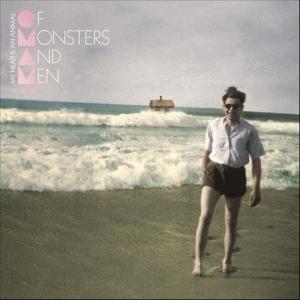We here at The Addison Recorder read stuff. We also watch stuff. And play stuff, even. Sometimes, that stuff is interesting. Sometimes we just need to talk about whatever pop culture ephemera occupies our time. Which brings us to this column. Clap on.
Travis
I’d intended to write this as a longer screed, but realized that I didn’t have much to say beyond “Listen to this!” I am rather open about the Counting Crows being one of my most favorite bands of all time. Their newest release, Somewhere Under Wonderland, came out in early September, and shows a continued push towards expanding on the band’s musicality while not really deviating too much from lead singer Adam Duritz’s introspective quest into his own myriad depression. (On a side note, I get why they turn a lot of people off – they’re a reeeeeally damn whiny band.)
Somewhere Under Wonderland pays heavy tribute to the Crows’ alt-country influences, while serving up a healthy portion of Duritz’s surrealist stream of consciousness lyrics, something like if James Joyce listened to a shit ton of Uncle Tupelo while on acid. As a result, some of the songs blur together in the mind. There are gems, though. “Palisades Park”, the first single, pays tribute to 1970’s New Jersey, and The Wild, The Innocent, and the E Street Shuffle-era Springsteen, while “Earthquake Driver” serves up a fairly autobiographical portrait of Duritz to a loose, bluesy shuffle. In an alternate universe, the Crows survive as one of the best jam bands of the 90’s – but that’s not who they are. They’re far more literate than Dave Mathews ever could hope to be.
The album is not without flaws, however. The main theme of wanderlust is driven home like a nail to the forehead by mentioning nearly all of the 50 states in songs by name, while Duritz seemingly brings back every girl he ever held hands with as a metaphor for loss – subtlety hasn’t been the Crows’ forte since the release of This Desert Life in 1999. Fortunately, the piano work of Charlie Gillingham, the guitar stylings of Dan Vickrey, and jack-of-all-instruments/band MVP David Immergluck, combined with the restrained wailing of Duritz, make this an album to recommend.
Meryl

OMAN’s “My Head is an Animal” came out in 2012. (Image via)
For the second month in a row, I’ve been obsessed with an album from 2012. You can always count on me for music recommendations that make you two years late to the party! This month, it’s Of Monsters and Men’s My Head is an Animal. Highlights include the upbeat “Mountain Sound” and the haunting “Dirty Paws.” When I shared this album with my brother on Spotify, he reminded me that the latter was featured prominently in the epic trailer for The Secret Life of Walter Mitty.
Also this month, I read Margaret Atwood’s devastating 1985 dystopian novel, The Handmaid’s Tale, on the recommendation of Christina here at the Recorder. It was a fascinating, albeit pretty upsetting, book, and I do look forward to reading more Atwood in the future. When I leave for Portland at the start of October, I plan to bring along Wild, the Cheryl Strayed memoir Travis wrote about back in June. A book about self-discovery in the Pacific Northwest seems in line with the theme of my trip, after all.
Andrew
In typical fashion for me, I read two books written about 350 years apart.
I’m turning thirty this month, so I decided to mark the passing decades by re-reading my favorite book of all time, James Boswell’s The Life of Samuel Johnson, and some of Johnson’s writings from his career as one of the leading figures of eighteenth-century literature. To my surprise, I found a great deal of remarkably relevant material in two of Johnson’s most famous works, both written as introductions to collected editions of other authors: the Preface to William Shakespeare (1765) and The Lives of the English Poets (1781, two years before his death).
These are more than great examples of aesthetically elaborate but structurally concise writing: in a lesson apt for the age of Internet commentary, Johnson demonstrates how to be critical and respectful at the same time. He discusses flaws and failings in a succinct, even-handed, respectful manner which never fails to convince the reader of both his sincerity and his (sometimes grudging) respect for the author in question’s talent. Anyone who wishes to excel as a critic should give the volumes of Johnson an examination. The names may be unfamiliar, but the style and structure have much to teach us. (The above links take you to the full texts of both works in question.)
Also, after multiple times weeping over The Fault in Our Stars and some heavy Crash Course viewing, my reading led me to my second John Green novel, 2006’s An Abundance of Katherines. The one certain statement I can make about this book is that I liked it a lot. Because on the surface, it shouldn’t work. Green writes a story whose centerpiece is a beautiful, complex mathematical formula (explained in a lengthy appendix by a UChicago professor), but which also includes a plethora of Wilde-worthy epigrams, Infinite Jest-style footnotes, and resonant themes relating to romance, faith, and the power of storytelling. There’s also a two-chapter-long action sequence featuring guns, wild animals, a knock-down fight to the finish, and two people having sex on a tombstone. Considering the novel is only 215 pages, the final cohesiveness of it all may be one of the ultimate testaments to Green’s powers. (The title also anagrams to Fauka had nineteen cobras, which might be important.)
Bean
I spent September watching a ton of TV documentaries: easily thirty hours’ worth while I worked or played video games or fell asleep. That time was spent primarily with a master of the form: Michael Wood. Wood is a British historian and television creator/star who has been delving into the past for the BBC for over thirty years. I stumbled across his work a few years ago on Netflix and have watched almost all of his series since then on one site or another online.
His specialty is the (literal) lengths he will go to in order to show his viewers the actual locations where historical events happened. His decades-spanning career has seen Wood trot through the ancient land boundaries of Anglo-Saxon-era England, the desserts of Central Asia on Alexander the Great’s routes, and up and down the Andes to track the Conquistadors’ chase of the Incas. The most stupefying of these was a journey on foot across the Himalayas from Nepal to Tibet in search of the legendary Shangri-La.
But even when not walking all over the planet he brings an unshakable enthusiasm and insight to the proceedings. History is an living joy for him and I find myself caught up in the same feeling even on re-watches. I’d say the best place to start with Wood is the stand-alone Christina: A Medieval Life, which uses the records of one specific woman in 14th century England to depict the existence of a medieval peasant, or In Search of Myths and Heroes – King Arthur, which tries to track the Arthurian legends to their origins in Sub-Roman Britain. Both show off Wood’s particular skill at making the past come alive in vivid and insightful fashion.
-J.
Funny thing: Bean and I were initially fighting over who was going to get to cover the video game Banner Saga as his “month in pop culture” post. And neither of us made the choice to cover it. (That said, it is an awesome game that reminds me of my favorite tactics games of yore, but with a different style of amazing art.)
Instead, I’m following last month’s example and going with a tabletop game I picked up at Gen Con this year, the fantasy role-playing game (RPG) 13th Age. It’s a bit odd to talk about an RPG other than D&D 5th edition right now, but after spending most of my game-related time last month running or writing about 13th Age, I absolutely love it.
When I was looking through the core book with a couple of friends, the prevalent question was, “what makes this different from D&D or Pathfinder?” It’s a valid query, as the primary authors of 13th Age are industry vets who were integral on different versions of D&D. After a few game sessions, I would highlight the differences in terms of Relationships, Backgrounds, and tone.
One of the greatest mechanics in 13th Age is the “Relationship Roll.” The game foregrounds players’ connections to the “Icons” of the story — thirteen living individuals who hold the most influence over the world. Each game, players roll dice for their relationships to these Icons, and the GM utilizes these results to shape the story and connect the events directly to the players’ characters. The dovetails perfectly with the focus on collaborative storytelling in this game, and alongside its other narrative-focused mechanics (like the use of broad backgrounds instead of specific skills), 13th Age doesn’t just tell you to spin a cracking good yarn — it gives you the gears, bells, and whistles to do it.
And it’s FUN, in tone and design. The writing in the 13th Age books both acknowledges and encourages different styles of play, and keeps the ludic quality of RPGs at the forefront. D&D‘s 5th edition may be the hot topic of the day, but I’ve rarely had as much fun with an RPG as I’ve had with 13th Age.
Christina
 I discovered singer-songwriter FKA twigs in Bitch Magazine where reviewer Katie Presley described her music in the most visceral way I’ve heard anyone describe music: “Breathy vocals are layered as thick as an icebox cake over beats that overlap and loop and tug the tone of the record from trippy to sexy to glitchy to smooth-as-silk R&B, sometimes within the course of a single song.” Whoa. Checkout the video for Two Weeks where FKA twigs sits and sings directly into the camera nearly the entire length of the four+-minute song as other versions of herself dance around her. You’ll feel something. Promise.
I discovered singer-songwriter FKA twigs in Bitch Magazine where reviewer Katie Presley described her music in the most visceral way I’ve heard anyone describe music: “Breathy vocals are layered as thick as an icebox cake over beats that overlap and loop and tug the tone of the record from trippy to sexy to glitchy to smooth-as-silk R&B, sometimes within the course of a single song.” Whoa. Checkout the video for Two Weeks where FKA twigs sits and sings directly into the camera nearly the entire length of the four+-minute song as other versions of herself dance around her. You’ll feel something. Promise.









